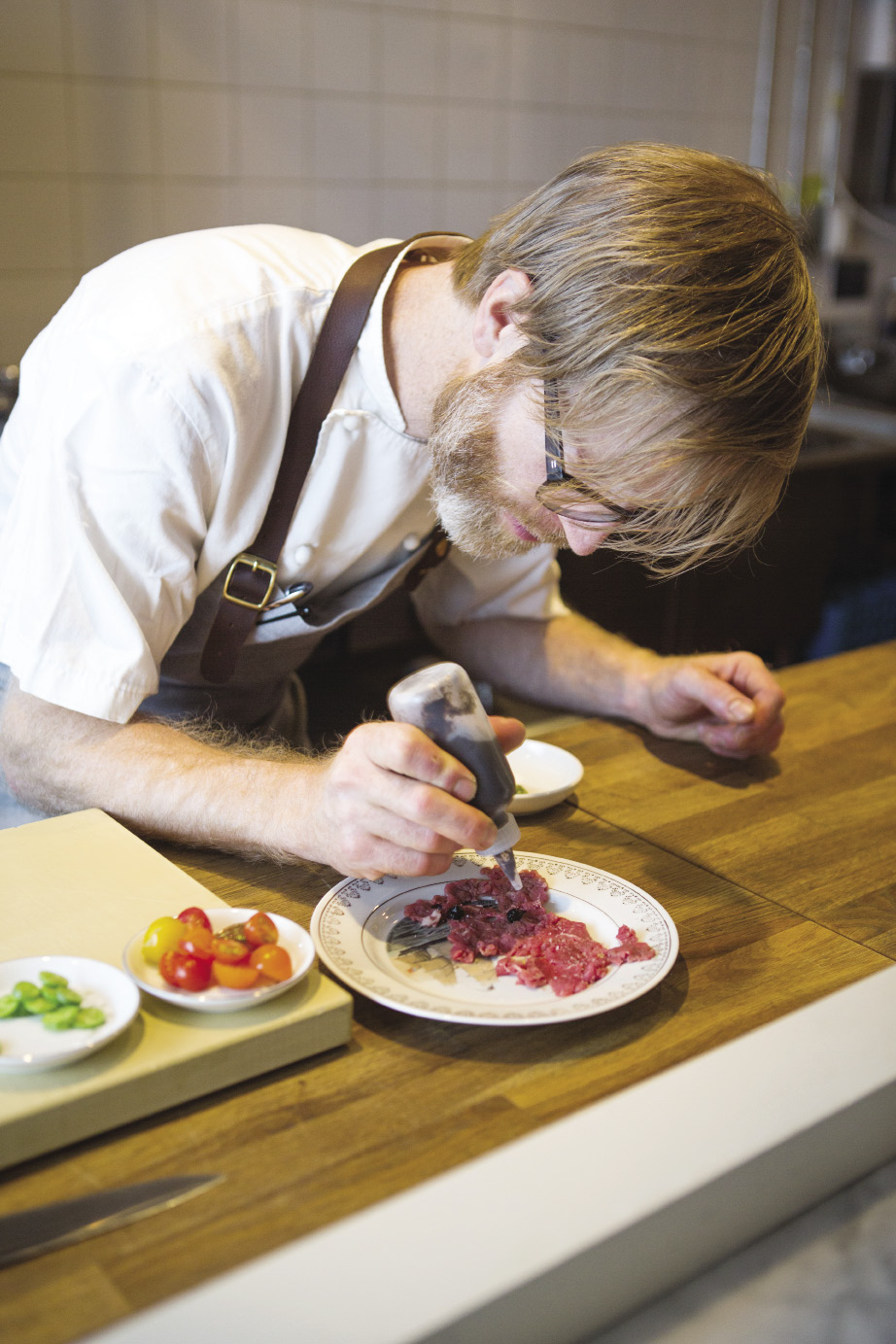GREENPOINT—On a recent Friday evening in the open kitchen at Luksus, chef Daniel Burns meticulously slipped paper-thin slices of radish into a light broth with raw razor clam, cucumber vinaigrette and seaweed puree.
And a hair the color of hay—which also happens to be an ingredient in the third dish on the Nova Scotia native’s Scandinavian tasting menu—falls over his black-rimmed glasses.
Without a word, Burns and cook David Ralston each lift two of the artfully mismatched dishes—one bone white, one printed with tiny yellow rosebuds—and, because the waitress is momentarily busy, personally deliver them to diners who are already sipping beers from the front half of this restaurant, which has already been called the best beer bar in Brooklyn, if not the world.
Danish for “luxury,” the name Luksus is intended as a tongue-in-cheek comment on fine dining, an industry with which Burns is intimately acquainted, thanks to stints at England’s three-Michelin-starred the Fat Duck and Copenhagen’s Noma, where he ran the pastry program for three years, along with David Chang’s Momofuku test kitchen.
Luksus is part two of his first solo venture, which began with the buzzy March opening of the beer bar Tørst here on Manhattan Avenue in Greenpoint. The bar doesn’t just serve extraordinary offerings—21 beers on tap and 200 in bottles—it also has a glass-enclosed control panel under the taps that allows the bartenders to adjust each beer’s mix of nitrogen and carbon dioxide, its compression and its temperature (there are four options, ranging from 38 degrees to 52 degrees).
The restaurant Luksus, opened four months later, is tucked behind the bar, but the food is anything but an afterthought.
The five-course tasting menu begins with three shareable “snacks,” which, during a recent seating, included fresh-from-the-sea mussels with Atlantic dulse; housemade slow-rise sourdough with whipped Ithaca butter; and carrots and beets interspersed with golden blobs of egg-based cream, all to be eaten by hand.
The market-driven menu will change with the harvests, but the opening spread includes a dish of charred-but-juicy Little Gem lettuce, chanterelle mushroom and a slow-cooked egg in a corncob and mushroom broth—the corn kernels themselves would appear at dessert, like a culinary incarnation of Chekhov’s gun principle. But first, tender lamb breast with lamb tongue, marble potatoes, wax beans, roasted sunchoke puree and soft burnt hay.
In case that experience isn’t Scandinavian enough for you, Burns will host occasional guest chefs from Denmark for collaborative dinners, beginning with Matt Orlando of Amass in Copenhagen as part of the North Festival in October.
Weekends, Tørst takes over the whole space, but Luksus serves dinner Tuesdays through Fridays for $75, along with—wait for it—optional beer pairings, curated by the Tørst team and Denmark’s Evil Twin brewer Jeppe Jarnit-Bjergsø. They’ve lined up hard-to-find Scandinavian brews such as Nomader Wit, with notes of orange and coriander; Noma Juniper, made using juniper extract; the Justin Blabaer blueberry beer and the salty and sour Leipziger Gose topped with a sweet housemade cherry cordial syrup.
The streamlined space—outfitted with oak and reclaimed wood, six skinny stools and a striking blackboard mural by Danish artist Eske Kath along the back wall—fills with laughter and inter-table conversations that grow louder as those beautiful beers flow.
Tørst’s Flux Capacitor: Better Drinking Through Technology
The beer program here goes beyond inspired selections. Tørst’s 21-tap system arms bartenders with an unprecedented level of quality control. Temperature, for starters: Kegs are kept in two separate rooms downstairs, a colder one for saisons and other lighter beers, and a cellar-temperature room for darker beers like barleywines and stouts.
“So you don’t have to cup the glass in your hand for 15 minutes to get it up to a temperature where you can taste all the roasty flavors,” says bar manager Mike Adimei. But the real innovation is the “flux capacitor.”
Most draft systems use a preset mix of carbon dioxide and nitrogen to keep the beer carbonated and push it through the lines to the tap. The flux capacitor allows the bartender to control that mix for each individual tap and thus serve each beer at its precise ideal carbonation level (a Belgian tripel might be 70/30 CO2 to nitrogen; a pale ale 60/40 and a stout 30/70). Adimei says they often consult the distributor or even the brewer to determine what’s optimum. It’s not as simple as it sounds. Carbonation manifests itself differently depending on temperature, the length of the tap lines and other factors. Adimei says they sometimes resort to a spreadsheet to work it out. Plus, with artisanal craft beers, the carbonation inside the keg may vary, so at some point the spreadsheet gets set aside and the art of the bartender takes over, fine tuning the mix to suit an individual keg.
Any bartender can pull on the tap handle, but the flux capacitor gives Tørst a real handle on their taps.
—Jim Clarke
Photo credit: Vicky Wasik



